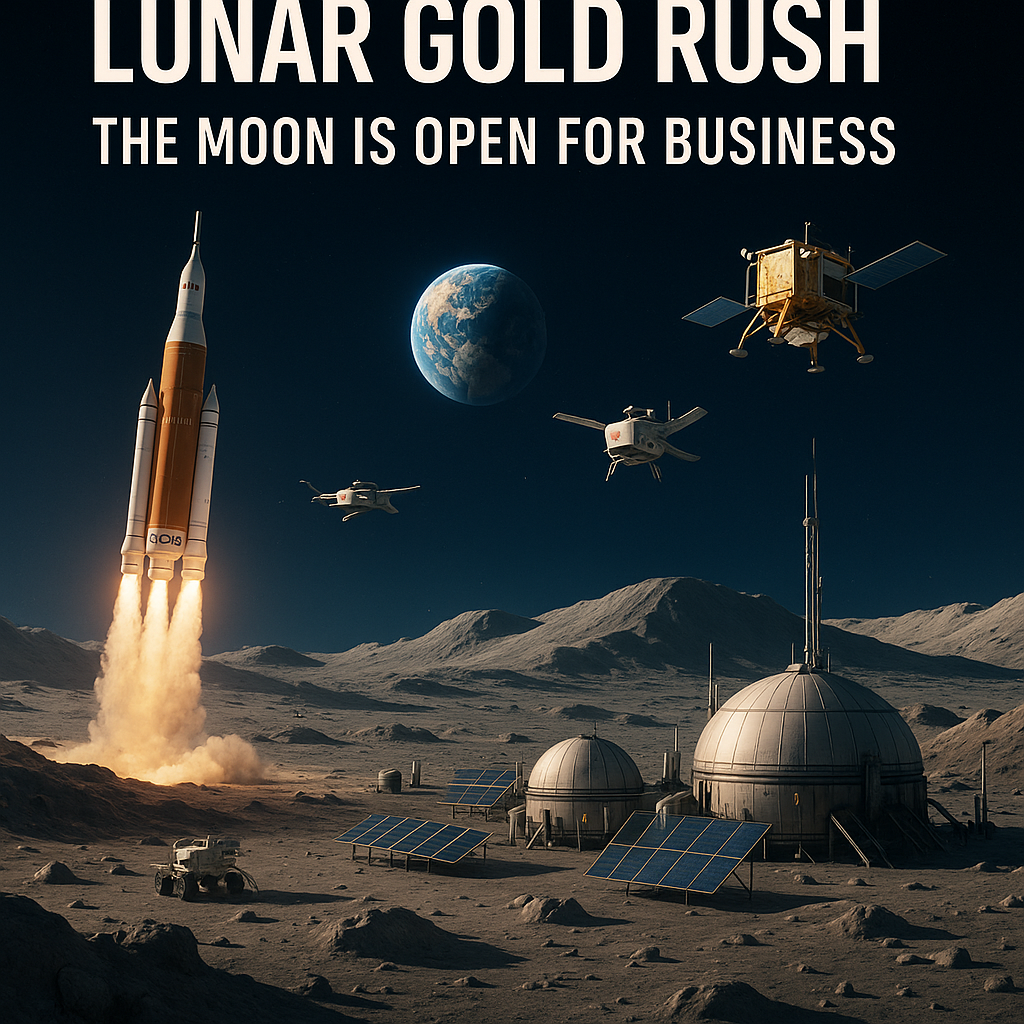Lunar Gold Rush: How the Moon Became the Next Frontier for Superpowers
In 2025, a new space race is unfolding not for flags, but for lunar dominance. The Moon’s rare resources, strategic location, and economic potential are driving global powers to build permanent infrastructure in space.

Introduction: The Moon Is Open for Business
Where the covert emblem of Cold War competition once reigned, the Moon now shines brightly again but not for flags and footprints alone. In 2025, a fresh space race is gaining momentum not to stake claims but to construct permanent lunar bases, extract resources such as helium-3, and develop strategic infrastructure on the surface of the Moon.
Leading the charge are NASA (USA), CNSA (China), and ISRO (India). All three of these space-faring countries are currently embarked on ambitious missions to construct lunar habitats, energy infrastructure, and robotic supply lines on the Moon paving the way to what many refer to as the "Lunar Gold Rush."
This time around, the Moon isn't an endpoint it's the departure point for a new frontier of extraterrestrial industrialization and strategic hegemony.
Why Are Nations Rushing Back to the Moon?
- Strategic Advantage
Dominion over the Moon implies:
- Early access to water ice (rocket fuel)
- Staging bases for missions further into space (e.g., Mars)
- Global prestige and soft power leverage
- Potential military vantage points (though prohibited, the prospect exists)
- Precious Lunar Resources
The Moon harbors:
- Helium-3: An uncommon isotope that would fuel future fusion reactors
- Rare Earth Elements: Vital to electronics and defense technology
- Water Ice: Present in polar craters—life and fuel essential
- Technological Spillover
From robotics and artificial intelligence to 3D printing and radiation protection, lunar missions develop technologies that spin off to benefit Earth industries—ranging from medicine to energy.
- Commercialization
Firms such as SpaceX, Blue Origin, and Astrobotic view the Moon as a money frontier providing services for landing, navigation, cargo, and even tourism.
NASA: The Artemis Program and Lunar Gateway
The Mission
NASA's Artemis Program, initiated in 2019, has the following goals:
- Send humans back to the Moon by 2026
- Construct the Lunar Gateway (a space station in lunar orbit)
- Establish Artemis Base Camp at the Moon's south pole
Key Milestones
- Artemis I (2022): Uncrewed lunar flyby
- Artemis II (2025): Crewed lunar orbit mission
- Artemis III (2026): First woman and person of color to land on Moon
Artemis Base Camp
Near Shackleton Crater, NASA base plans to have:
- Habitat modules
- Power stations
- Rovers and scientific labs
- Integration with SpaceX Starship lunar landers
Partnerships
- SpaceX: Chosen for lunar lander (Starship HLS)
- ESA, JAXA, CSA: International modules and crew support
- Commercial Lunar Payload Services (CLPS): Public-private partnerships with landers
Why It Matters: America desires not only to lead in discovery, but to write the rulebook on lunar management, including traffic regulation and ownership rights to resources.
China: The International Lunar Research Station (ILRS)
China's Ambitions
China National Space Administration (CNSA), in partnership with Russia's Roscosmos, is developing the ILRS (International Lunar Research Station) by 2030.
Key Details
Location: South pole region
Objective: Permanent, autonomous research base with power, comms, and science labs
Phases:
- 2026–2028: Robotic precursor missions
- 2029–2035: Construction and crewed landings
Past & Future Missions
- Chang'e-4 (2019): First soft landing on Moon's far side
- Chang'e-5 (2020): Brought lunar samples back to Earth
- Chang'e-6 (2024): Sample return from far side
- Chang'e-7 (2026): South pole reconnaissance
- Chang'e-8 (2028): ISRU tech demo
Technology
China is prioritizing:
- Lunar 3D printing for habitats
- Autonomous power systems
- Robotic excavation for regolith and ice
International Partners
Whereas Western space agencies are more in sync with NASA, China is extending partnerships to Asian, African, and Middle Eastern nations—placing ILRS as an alternative to Artemis.
India: From Chandrayaan to Crewed Lunar Plans
ISRO's Current & Future Roadmap
India's ISRO (Indian Space Research Organisation) joined the lunar race with the Chandrayaan program:
- Chandrayaan-1 (2008): Presence of water on the Moon confirmed
- Chandrayaan-2 (2019): Orbiter successful; lander crash
- Chandrayaan-3 (2023): Successful south pole soft landing—the first in the world
Upcoming Plans
- Chandrayaan-4 (2026–27): Suggested sample return mission
- Gaganyaan (2025–26): First Indian human spaceflight—extended to lunar missions in 2030s
Lunar Base Concepts
- ISRO is working with JAXA (Japan) on joint lunar lander missions and rover development.
- India is considering robotic and hybrid systems for surface operations, with increasing interest in commercial collaboration.
Why India Matters
India's achievement in affordable space engineering, along with geopolitical partners and emergent private sector (e.g., Skyroot, Agnikul), makes it a surprise player in the race to the moon base.
Technology Fuelling Lunar Colonization
- ISRU (In-Situ Resource Utilization)
- Oxygen extraction from regolith
- Mining water ice for hydrogen fuel
- Utilizing lunar soil to 3D print buildings
- Autonomous Robotics
- Rovers and robotic arms for mining, construction, and logistics
- AI-driven fault detection in habitats
- Radiation Shielding & Thermal Control
- Regolith-based bunkers and reflectors
- Subsurface habitats
- Power Systems
- Solar arrays with battery banks
- Small modular nuclear reactors (NASA's Kilopower program under test)
- Space Communications & Navigation
- Lunar GPS constellations
- Real-time comms relay satellites in halo orbit
Legal and Geopolitical Tensions
The Space Treaty Dilemma
The 1967 Outer Space Treaty bans national ownership of celestial bodies. Interpretations differ on resource extraction.
- The U.S. Artemis Accords: Encourage peaceful, open use of lunar resources. Adopted by 36 nations (not Russia or China).
- China and Russia: Blame the U.S. for promoting unilateral "space colonialism."
- India: Has not yet adopted the Artemis Accords, holding strategic independence.
Military Concerns
Although space is professed for "peaceful use," most experts caution against a dual-use danger:
- Communications, tracking, and energy systems might be diverted to defense
- Strategic occupation of high-value areas (e.g., south pole) might lead to diplomatic confrontations
Private Sector and the Commercial Gold Rush
Key Players
- SpaceX: Lunar landers (Starship), cargo delivery
- Blue Origin: Blue Moon lander, lunar fuel depot plans
- Astrobotic & Intuitive Machines: CLPS contract holders
- ISRO Startups: Skyroot, Agnikul, Pixxel
Business Models
- Resource mining (helium-3, ice)
- Payload delivery and communications
- Lunar tourism and surface exploration
- Infrastructure as a service: power, habitat, logistics
Investment Trends
- More than $20 billion in private lunar investment estimated by 2030
- Government contracts are spurring private R&D—particularly in the U.S. and India
What's Next?
Conclusion: The Moon Is the New Geopolitical High Ground
The Moon is not a scientific curiosity anymore it's a geopolitical chessboard, an economic goldmine, and a tech testbed. Whether water for fuel, helium-3 for energy, or infrastructure for deep-space travel, whoever establishes the first sustainable lunar base will have a strategic advantage for decades to come.
But this race requires international cooperation, moral codes, and peaceful protocols. Without firm governance, the Lunar Gold Rush may become the next frontier of war.
With the countdown starting for permanent settlements off Earth, the world has a choice to make: will the Moon bring us together, or tear us apart anew?
Sources
- NASA Artemis Program Official Site
- China National Space Administration Press Center
- ISRO Chandrayaan Mission Reports
- Reuters Space News
- Space.com - Lunar Gateway Updates
- Google Trends
- CourtListener Legal Archive on Artemis Accords
- Justia – International Space Law Cases
- Archive.org – Historical NASA Moon Mission PDFs
- United Nations Office for Outer Space Affairs (UNOOSA)
For more legal exposes and truth-behind-glamour stories, subscribe to AllegedlyNewsNetwork.com




